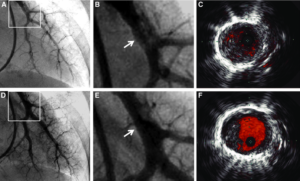Intravascular Ultrasound (IVUS) is a medical imaging technique that is used to visualize the interior of blood vessels, specifically the coronary arteries. IVUS is often used during angioplasty, a procedure to open blocked or narrowed blood vessels, to help guide the treatment and ensure its success.

Angioplasty is a common treatment for coronary artery disease (CAD), which is the buildup of plaque in the coronary arteries that can restrict blood flow to the heart muscle. During angioplasty, a balloon catheter is inserted into the affected blood vessel and inflated to compress the plaque and improve blood flow.
IVUS is a valuable tool for angioplasty because it provides real-time imaging of the inside of the blood vessels, allowing the physician to see the location and size of the plaque, the size of the blood vessel, and the degree of stenosis (narrowing) before, during, and after the procedure. This information is critical for making informed decisions about the angioplasty procedure, such as choosing the appropriate size and type of stent, and assessing the success of the treatment.
IVUS is a minimally invasive procedure that is performed in conjunction with angioplasty. A small IVUS catheter, which contains a miniature ultrasound transducer, is inserted into the blood vessel through a small incision in the groin area. The transducer sends high-frequency sound waves into the blood vessel and captures the returning echoes to produce detailed images of the blood vessel walls and plaque.
Use of IVUS (Intravascular Ultrasound)
The use of IVUS during angioplasty has been shown to improve clinical outcomes. In several clinical studies, IVUS-guided angioplasty has been associated with a lower rate of restenosis (recurrent narrowing of the blood vessel) compared to angioplasty without IVUS. This is likely because IVUS provides detailed information about the blood vessel and plaque that is not available with other imaging techniques, allowing the physician to make more informed decisions about the angioplasty procedure and to adjust the treatment as needed.
In addition to its use in angioplasty, IVUS is also used in other procedures, such as the placement of stents and the evaluation of blood flow in the coronary arteries. IVUS has been shown to improve the success rates of these procedures and to reduce the risk of complications.
In conclusion, IVUS is a valuable tool for physicians in the field of cardiovascular medicine, helping to improve the outcomes of angioplasty and other related procedures. By providing real-time imaging of the blood vessels, IVUS helps guide the treatment and ensure its success, leading to better clinical outcomes.
If you are scheduled to undergo an angioplasty procedure, it is important to discuss with your physician the potential benefits of incorporating IVUS technology into your treatment plan. You can contact for IVUS in Angioplasty procedure, Dr. Atul Kasliwal. He is the best Cardiologist in Rajasthan. For more details, you can visit at his clinic at Kasliwal Heart Care.